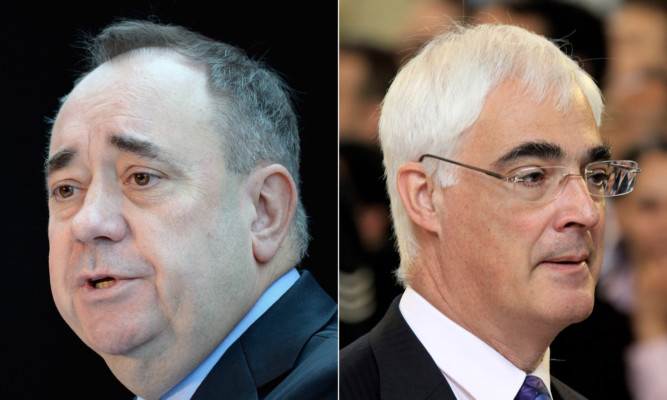The debate over Scottish independence will enter a new phase with the first live television clash between the First Minister and the man leading the campaign to keep the UK together.
Alex Salmond will take on former chancellor Alistair Darling, the chair of the pro-UK Better Together group, in a two-hour long TV debate programme.
The head-to-head showdown between the two men will be shown on television across Scotland on STV and in some parts of England in the ITV Border region. Viewers across the globe will also be able to watch it live online.
There are now just over six weeks to go until voters in Scotland decide whether to remain in the UK or become an independent nation in the September 18 referendum.
Polls have so far failed to show a majority in favour of independence, but both campaigns are hoping to to receive a boost in support as a result of tonight’s TV debate.
Lengthy negotiations have taken place in the run up to the high-profile clash, with Mr Salmond initially having refused to debate the former chancellor as he repeatedly called on Prime Minister David Cameron to debate the issues with him.
But the Conservative leader consistently refused to take part in such an event.
The debate will get underway with a new poll looking at how people are planning to vote in the referendum followed opening statements from both politicians.
STV’s political editor Bernard Ponsonby, who will host the debate in front of an audience of 350 at the Royal Conservatoire of Scotland in Glasgow, will quiz both Mr Salmond and Mr Darling.
The pair will then cross examine each other, before being questioned by members of the audience.
Ahead of the debate No campaigners called for “straight answers” from Mr Salmon on the impact of leaving the UK, while those campaigning for independence insisted they were winning over undecided voters.
Blair McDougall, campaign director for Better Together, said: “Voters in Scotland have been listening to the independence debate for over two years now. Surely if Alex Salmond had convincing answers on the details of separation, we would have heard them by now.
“Scots tuning in deserve to finally get straight answers from Mr Salmond to the questions they have been asking. What would separation mean for our pound, pensions and public services?”
He added: “Unlike the Leaders’ Debates in the 2010 general election, this debate isn’t a job interview between candidates. Instead, it is a discussion about what separation would mean for our children and grandchildren’s futures.
“The referendum debate isn’t confined to TV studios. It is taking place in conversations between friends and family across Scotland. The biggest debate is taking place on the doorsteps, around kitchen tables and in workplaces across the country. And the more people talk about what leaving the UK would mean for our schools and hospitals, the more they are saying no thanks to separation.”
Yes Scotland chief executive Blair Jenkins said: “Independence is the opportunity of a lifetime for the people of Scotland, and the Yes campaign are looking forward immensely to the debate.
“We know that Scotland is one of the richest countries in the world, wealthier than the UK, France and Japan, and only the powers offered by a Yes vote will enable us to make this wealth work better for everyone in Scotland.”
Mr Jenkins added: “Viewers will get the chance to hear why decisions made on Scotland’s future should be taken here in Scotland. Our experience is that most undecided voters choose Yes when they hear both sides of the debate, and therefore we believe the mass TV audience will benefit our positive campaign.
“We also believe that the No campaign have a problem with both the negativity of their message, and the unpopularity of their messengers. The Yes leaders all have positive ratings because they are trusted, and the No leaders’ ratings are all negative – including Alistair Darling at -16.
“Other poll evidence shows that people regard the Yes campaign as being more effective than No by a factor of two-to-one. Yes is already at 47% in the latest poll, and we are confident about winning a majority on September 18.
“The evidence shows that the people of Scotland trust Yes and don’t trust No – and we believe that by winning the campaign, Yes can and will win the referendum.”
